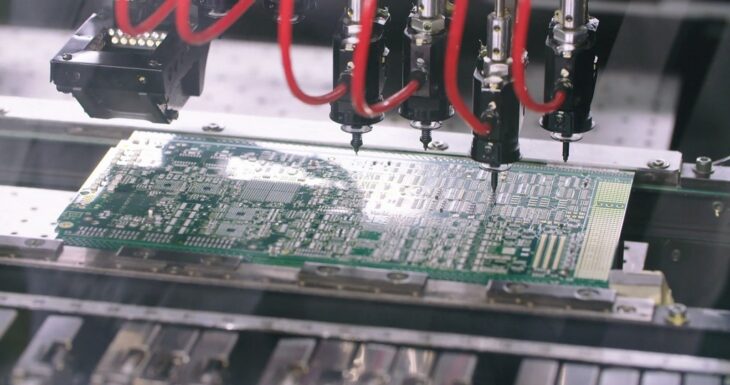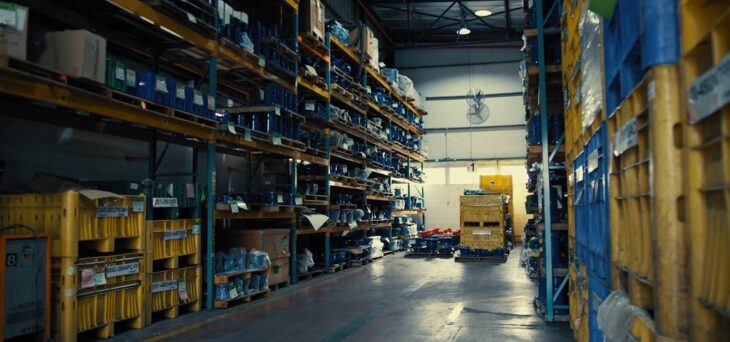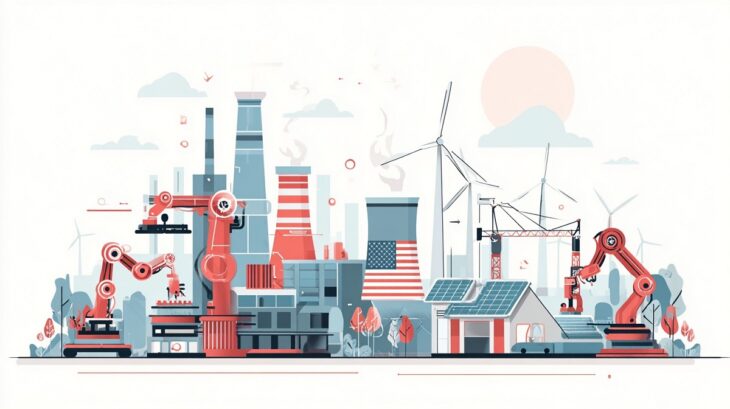Renewed interest in U.S. manufacturing marks a crucial shift in the nation’s economic direction.
A growing focus on building, producing, and innovating within national borders reflects an awareness of global uncertainties and supply chain vulnerabilities.
Domestic manufacturing plays a vital role in economic security by creating stable jobs and driving technological progress.
Recent years have also seen competing visions on how to sustain this growth, some advocate for strategic, long-term investments supported by industrial policy, while others lean toward tariff-driven protectionism.
Together, these contrasting paths are shaping the country’s manufacturing identity and its broader economic future.
Table of Contents
ToggleKey Trends Shaping the Manufacturing Resurgence
A renewed industrial momentum is reshaping the structure of U.S. manufacturing, blending:
- Government policies
- Technological advancements
- Shifting corporate strategies
Several interconnected trends have contributed to this transformation, including targeted federal investments, evolving trade policies, and a focus on domestic production as a strategic priority.
Strategic Industrial Policy and Federal Investment

Strategic public investment has become the backbone of the manufacturing revival.
Government-backed initiatives are not merely aimed at short-term stimulus but at re-establishing industrial independence.
Through programs designed to foster research, development, and production capabilities, the federal government is laying the foundation for sustained industrial growth.
Key areas receiving attention include:
- Semiconductors – Federal funding supports chip fabrication plants critical for electronics and defense.
- Clean energy – Investments accelerate battery production, solar innovation, and electric vehicle components.
- Defense manufacturing – Domestic sourcing for military-grade materials enhances national security.
Collaboration between private companies and public institutions has proven vital for accelerating technological progress.
The CHIPS and Science Act is one example, designed to restore competitiveness by encouraging the reshoring of advanced manufacturing.
Research and development programs now focus on emerging fields like robotics, AI-driven automation, and advanced materials.
The Role of Tariffs and Protectionist Measures
Trade policy has played a major role in reshaping industrial priorities.
While federal investments create the foundation for innovation, tariffs and protectionist measures have attempted to reinforce domestic competitiveness by discouraging foreign reliance.
The tariff-centered “America First” strategy brought both benefits and complications.
Short-term gains for certain industries were offset by supply chain turbulence and fluctuating costs.
Many companies faced higher input prices, forcing them to rethink sourcing and logistics strategies.
Key outcomes of this approach include:
- Increased efforts toward localized manufacturing and reshoring.
- Greater emphasis on supply chain diversification to mitigate risk.
- Heightened awareness of global trade dependencies and their economic consequences.
While protectionism offered some relief to local producers, sustainable growth now appears tied to consistency and long-term investment, not reactive tariff cycles.
Companies are learning that innovation-driven competitiveness provides a more durable advantage than policy barriers alone.
Economic Impacts of the Manufacturing Comeback
Industrial resurgence is reshaping the U.S. economy through employment expansion, strengthened supply chains, and advanced technological capabilities.
New factories, innovation hubs, and research facilities are creating fresh opportunities for communities nationwide.
However, this revival also exposes existing weaknesses in the labor force and infrastructure.
Supply Chain Resilience

Supply chain resilience has become one of the most significant benefits of reshoring.
Domestic production reduces dependency on unpredictable international markets and logistical bottlenecks.
Companies can respond faster to disruptions and ensure consistent quality across product lines.
Several measures have contributed to stronger supply chains:
- Regionalized hubs that bring production closer to end-users.
- Infrastructure upgrades improving transportation and logistics.
- Technology adoption through automation and smart warehousing.
Innovations like automated storage systems and improved mobility solutions, such as wheels and casters, have enhanced efficiency in warehouse and factory operations.
Shorter delivery routes and local sourcing also lower emissions and costs, aligning economic growth with environmental responsibility.
Reshoring has evolved into a risk management strategy that builds stability across entire supply networks.
Job Creation and Labor Market Challenges
Rising manufacturing activity is driving substantial job growth, but it also highlights critical workforce shortages.
Modern factories depend on skilled professionals capable of managing complex machinery, robotics, and data systems.
Unfortunately, outdated perceptions about manufacturing as low-skill labor have deterred younger generations from entering the field.
Solutions require collaborative action among employers, educators, and policymakers.
Apprenticeship programs, technical schools, and re-skilling initiatives are helping bridge the gap.
Manufacturing’s renewed image as a high-tech, stable, and innovative career path is essential to attracting new talent and sustaining growth.
Technological Innovation and Automation
Rapid technological advancement is transforming every aspect of production.
AI integration, robotics, and smart sensors are enabling companies to achieve precision and consistency at unprecedented levels.
Key technological breakthroughs driving progress include:
- Smart factories utilizing real-time data to optimize performance.
- AI-driven predictive maintenance reducing downtime and costs.
- Industrial metaverse applications supporting virtual training and design simulations.
Manufacturers are embracing connected systems that enable instant communication between machines, data centers, and human operators.
While automation may reduce certain manual positions, it simultaneously generates new opportunities for high-skilled labor in engineering, programming, and systems management.
Challenges and Constraints
Despite optimism, the manufacturing resurgence faces structural barriers that could limit growth.
Workforce Development and Talent Gaps
Recruitment difficulties are among the most pressing issues facing manufacturers.
Perceptions of repetitive, low-wage work persist, even as modern facilities resemble high-tech labs.
Limited educational outreach and insufficient vocational training programs have further slowed the growth of skilled labor.
Efforts to address talent gaps must include:
- STEM education expansion to prepare students for industrial technology roles.
- Industry-academic partnerships fostering specialized curricula.
- Public campaigns to rebrand manufacturing as forward-thinking and rewarding.
A national strategy for workforce development could integrate community colleges, industry associations, and federal programs into a single ecosystem for skill-building.
Only through this alignment can the sector overcome its labor shortages and sustain innovation.
Regulatory, Financial, and Construction Hurdles
Launching new production facilities often involves significant upfront costs and complex approval processes.
Rising land prices, regulatory red tape, and equipment expenses can delay progress.
Financial caution during volatile markets adds another layer of difficulty, especially for small and mid-sized firms.
To counter these issues, policymakers and industry leaders advocate for modernized infrastructure, tax incentives, and simplified regulatory pathways.
Global Disruptions and Inflationary Pressures
External shocks continue to influence domestic manufacturing. Inflation, international tensions, and fluctuating tariffs all drive up the cost of materials and energy.
Companies have responded by stockpiling critical inputs and diversifying global supply networks to maintain stability.
Key global factors affecting the industry include:
- Energy price volatility impacting production budgets.
- Material shortages due to trade restrictions or conflict.
- Growing competition as foreign markets ramp up industrial policy.
Adapting to these conditions requires flexibility and innovation. Businesses must invest in digital forecasting tools, diversify their sourcing, and adopt agile manufacturing methods to protect profitability in uncertain times.
Sectoral Focus: Where Reshoring Is Thriving

Certain industries have become leaders in the resurgence due to their strategic importance and potential for innovation. Technology-intensive fields are drawing significant investment as companies seek to strengthen domestic capabilities.
Prominent sectors leading the reshoring wave include:
Semiconductors for computing, communication, and defense technologies.
Aerospace manufacturing essential for both commercial and military applications.
Clean energy production driving the transition toward sustainability.
Electric vehicle components establishing new industrial clusters in the Midwest and South.
These sectors not only stimulate regional economies but also generate secondary benefits through supporting industries such as materials, logistics, and engineering services. Collaboration among local governments, universities, and investors has transformed former manufacturing regions into modern innovation corridors, setting a strong foundation for long-term industrial vitality.
The Bottom Line
U.S. manufacturing is undergoing a true transformation driven by innovation, investment, and strategic foresight.
The resurgence is reshaping employment patterns, strengthening supply chains, and redefining economic competitiveness.
If pursued wisely, the movement toward domestic manufacturing can serve as a foundation for sustained growth and renewed confidence in the American economy.


